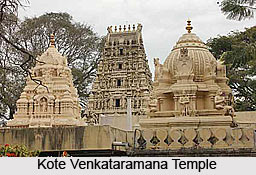 Kote Venkataramana Temple, enshrining the idol of Lord Venkateshwara, is located Krishnarajendra Road in Bengaluru in Indian state of Karnataka. Built in 1689 A.D., the temple reflects the Dravidian and Vijayanagara style of architecture.
Kote Venkataramana Temple, enshrining the idol of Lord Venkateshwara, is located Krishnarajendra Road in Bengaluru in Indian state of Karnataka. Built in 1689 A.D., the temple reflects the Dravidian and Vijayanagara style of architecture.
Architecture of Kote Venkataramana Temple
Kote Venkataramana Temple, dating back to the 17th century, was built during the reign of Chikka Devaraja Wodeyar, the then ruler of Mysore. In Kannada language the word kote means fort. Presently, this pilgrimage centre stands adjacent to the house of Mysore Wodeyar royal family that was later converted into the palace of Tipu Sultan, a monarch the Mysore Kingdom.
The sanctum sanctorum or the garbhagriha of the temple houses the idol of Lord Venkateshwara. The vestibule connects the garbhagriha to the central hall. Simple and modest architectural work defines this religious abode. The temple walls and the antechamber remain unadorned, excluding its base that has been fabricated with deity sculptures arranged in a row. The pillars in the four corners have "clusters of colonettes" interchanging with yalis i.e. mythical beasts of Hindu legend. These lend support to the hall ceilings. This prototype is common for all the central columns. Built, following the customary patterns and plans of the Mysore temple, the religious centre depicts the aesthetic sense of the artisans of the ancient period.
Kote Venkataramana Temple elaborately celebrates the festival of Vaikuntha Ekadashi, drawing hordes of devotees from various locations.
This article is a stub. You can enrich by adding more information to it. Send your Write Up to content@indianetzone.com





















